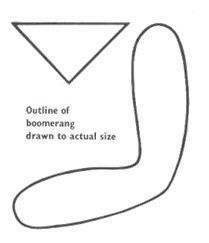Chapter: SCIENCE EXPERIMENTS & AMUSEMENTS FOR CHILDREN BY CHARLES VIVIAN. Simple Technical Steped Practical Projects for school and college students.
Make a Boomerang

Make a Boomerang

When you make a paper
airplane and glide it across the room you are making use of a condition known
as 'passive flight.'
Man had to gain knowledge
of 'active flight,' however, before he could produce airplanes. One of the
earliest forms of active flight is the boomerang used by the aborigines of
Australia, and we can observe this in action.
The chief characteristic of
this weapon is its ability to return to the thrower. A working boomerang can
easily be cut from cardboard. Draw the outline of a small boomerang on a piece
of thin cardboard, copying the diagram.
Cut your
boomerang out and then balance it on your left fore finger. Flick one of the
legs of the boomerang sharply with your other forefinger. It will take off and
revolve through the air like a small propeller before returning to you.
Now try the same experiment
with a small triangle of card cut to the size shown. Cut another triangle twice
as large as the first and note what difference there is in its active flight
compared with that of the small triangle.

Children learn best through doing
Before children can
understand a thing, they need experience: seeing, touching, hearing, tasting,
smelling; choosing, arranging, putting things together, taking things apart.
Experimenting with real things.
Old-time school teaching
used only words and the teachers thought children knew something if they could
repeat it. Now we know better. To reach practical understanding we do not need
to use many words with young children.
Children are
clever. They learn a lot, without being taught. The greatest skill - to be able
to talk, to communicate is learnt outside school. In the classroom it's the
children who need to talk the most. Unfortunately it is the teacher who does
most of the talking!
Related Topics